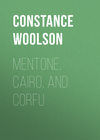Читать книгу: «Mentone, Cairo, and Corfu», страница 9
II
"I love the Arabian language for three reasons: because I am an Arab myself; because the Koran is in Arabic; because Arabic is the language of Paradise." This hadith, or saying, of Mohammed might be put upon the banner of the old university of Cairo, El Azhar; that is, the Splendid. El Azhar was founded in the tenth century, when Cairo itself was hardly more than a name. In its unmoved attachment to the beliefs of its founders, to their old enthusiasms, their methods and hates, El Azhar has opposed an inflexible front to the advance of European ideas, sending out year after year its hundreds of pupils to all parts of Egypt and to Nubia, to the Soudan and to Morocco, to Turkey, Arabia, and Syria, to India and Ceylon, and to the borders of Persia, believing that so long as it could keep the education of the young in its grasp the reign of the Prophet was secure. It is to-day the most important Mohammedan college in the world; for though it has no longer the twenty thousand students who crowded its courts in the thirteenth and fourteenth centuries, there is still an annual attendance of from seven to ten thousand; by some authorities the number is given as twelve thousand. The twelve thousand have no academic groves; they have not even one tree. There is nothing sequestered about El Azhar; it is near the bazaars in the old part of the town, where the houses are crowded together like wasps' nests. One sees nothing of it as one approaches save the minarets above, and in the narrow, crowded lane an outer portal. Here the visitor must show his permit and put on the mosque-shoes, for El Azhar was once a mosque, and is now mosque and university combined. After the shoes are on he steps over the low bar, and finds himself within the porch, which is a marvel as it stands, with its fretwork, carved stones, faded reds, and those old plaques of inscription which excite one's curiosity so desperately, and which no dragoman can ever translate, no matter in how many languages he can complacently ask, "You satisfi?" One soon learns something of the older tongue; hieroglyphics are not difficult; any one with eyes can discover after a while that the A of the ancient Egyptians is, often, a bird who bears a strong resemblance to a pigeon; that their L is a lion; and that the name of the builder of the Great Pyramid, for instance, is represented by a design which looks like two freshly hatched chickens, a football, and a horned lizard (speaking, of course, respectfully of them all). But one can never find out the meaning of the tantalizing characters, so many thousand years nearer our own day, which confront us, surrounded by arabesques, over old Cairo gateways, across the fronts of the street fountains, or inscribed in faded gilt on the crumbling walls of mosques. It is probable that they are Kufic, and one would hardly demand, I suppose, that an English guide should read black-letter? But who can be reasonable in the land of Aladdin's Lamp?
The porch leads to the large central court, which is open to the sky, the breeze, and the birds; and this last is not merely a possibility, for birds of all kinds are numerous in Egypt, and unmolested. On the pavement of this court, squatting in groups, are hundreds of the turbaned students, some studying aloud, some reading aloud (it is always aloud), some listening to a professor (who also squats), some eating their frugal meals, some mending their clothes, and some merely chatting. These groups are so many and so close together that often the visitor can only make the circuit of the place on its outskirts; he cannot cross. There is generally a carrier of drinking-water making his rounds amid the serried ranks. "For whoever is thirsty, here is water from God," he chants. One is almost afraid to put down the melodious phrase, for the street cries of Cairo have become as trite as the Ranz des Vaches of Switzerland. Still, some of them are so imaginative and quaint that they should be rescued from triteness and made classic. Here is one which is chanted by the seller of vegetables – the best beans, it should be explained, come from Embebeh, beyond Boulak – "Help, O Embebeh, help! The beans of Embebeh are better than almonds. Oh-h, how sweet are the little sons of the river!" (This last phrase makes poetical allusion to the soaking in Nile water, which is required before the beans can be cooked.) Certain famous baked beans nearer home also require preliminary soaking. Let us imagine a huckster calling out in Boston streets, as he pursues his way: "Help, O Beverly, help! The beans of Beverly are better than peaches. Oh-h, how sweet are the little sons of Cochituate!"
The central court of the Splendid is surrounded by colonnades, whose walls are now undergoing repairs; but the propping beams do not appear to disturb either the pupils or teachers. On the east side is the sanctuary, which is also a school-room, but a covered one; it is a large, low-ceilinged hall, covering an area of thirty-six hundred square yards; by day its light is dusky; by night it is illuminated by twelve hundred twinkling little lamps suspended from the ceiling by bronze chains. The roof is supported by three hundred and eighty antique columns of marble and granite placed in irregular ranges; there are so many of these pillars that to be among them is like standing in a grove. The pavement is smoothly covered with straw matting; and here also are assembled throngs of pupils – some studying, some reciting, some asleep. I paid many visits to El Azhar, moving about quietly with my venerable little dragoman, whom I had selected for an unusual accomplishment – silence. One day I came upon an arithmetic class; the professor, a thin, ardent-eyed man of forty, was squatted upon a beautiful Turkish rug at the base of a granite column; his class of boys, numbering thirty, were squatted in a half-circle facing him, their slates on the matting before them. The professor had a small black-board which he had propped up so that all could see it, and there on its surface I saw inscribed that enemy of my own youth, a sum in fractions – three-eighths of seven-ninths of twelve-twentieths of ten-thirty-fifths, and so on; evidently the terrible thing is as savage as ever! The professor grew excited; he harangued his pupils; he did the sum over and over, rubbing out and rewriting his ferocious conundrum with a bit of chalk. Slender Arabian hands tried the sum furtively on the little slates; but no one had accomplished the task when, afraid of being remarked, I at last turned away.
The outfit of a well-provided student at El Azhar consists of a rug, a low desk like a small portfolio-easel, a Koran, a slate, an inkstand, and an earthen dish. Instruction is free, and boys are admitted at the early age of eight years. The majority of the pupils do not remain after their twelfth or fourteenth year; a large number, however, pursue their studies much longer, and old students return from time to time to obtain further instruction, so that it is not uncommon to see a gray-bearded pupil studying by the side of a child who might be his grandson. To me it seemed that two-thirds of the students were men between thirty and forty years of age; but this may have been because one noticed them more, as collegians so mature are an unusual sight for American eyes.
All the pupils bow as they study, with a motion like that of the bowing porcelain mandarins. The custom is attributed to the necessity for bending the head whenever the name of Allah is encountered; as the first text-book is always the Koran, children have found it easier to bow at regular intervals with an even motion than to watch for the numerous repetitions of the name. The habit thus formed in childhood remains, and one often sees old merchants in the bazaars reading for their own entertainment, and bowing to and fro as they read. I have even beheld young men, smartly dressed in full European attire, who, lost in the interest of a newspaper, had forgotten themselves for the moment, and were bending to and fro unconsciously at the door of a French café. A nation that enjoys the rocking-chair ought to understand this. Some of the students of El Azhar have rooms outside, but many of them possess no other shelter than these two courts, where they sleep upon their rugs spread over the matting or pavement. Food can be brought in at pleasure, but those two Oriental time-consumers, pipes and coffee, are not allowed within the precincts. In one of the porches barbers are established; there is generally a row of students undergoing the process of head-shaving. The fierce, fanatical blind pupils, so often described in the past by travellers, are no longer there; the porter can show only their empty school-room. Blindness is prevalent in Egypt; no doubt the sunshine of the long summer has something to do with it, but another cause is the neglected condition of young children. There is no belief so firmly established in the minds of Egyptian mothers as the superstition that the child who is clean and well-dressed will inevitably attract the dreaded evil-eye, and suffer ever afterwards from the effects of the malign glance. I have seen women who evidently belonged to the upper ranks of the middle class – women dressed in silk, with gold ornaments, and a following servant – who were accompanied by a poor baby of two or three years of age, so dirty, so squalid and neglected, that any one unacquainted with the country would have supposed it to be the child of a beggar.
In addition to the bowing motion, instruction at El Azhar is aided by a mnemonic system, the rules of grammar, and other lessons also, being given in rhyme. I suppose our public schools are above devices of this sort; but there are some of us among the elders who still fly mentally, when the subject of English history comes up, to that useful poem beginning "First, William the Norman;" and I have heard of the rules for the use of "shall" and "will" being properly remembered only when set to the tune of "Scotland's burning!" Surely any tune – even "Man the Life-boat" – would become valuable if it could clear up the bogs of the subjunctive.
It must be mentioned that El Azhar did not invent its mnemonics; it has inherited them from the past. All the mediæval universities made use of the system.
The central court is surrounded on three sides by chambers, one of which belongs to each country and to each Egyptian province represented at the college. These sombre apartments are filled with oddly-shaped wardrobes, which are assigned to the students for their clothes. There is a legend connected with these rooms: At dusk a man whose heart is pure is sometimes permitted to see the elves who come at that hour to play games in the inner court under the columns; here they run races, they chase each other over the matting, they climb the pillars, and indulge in a thousand antics. The little creatures are said to live in the wardrobes, and each student occasionally places a few flowers within, to avert from himself the danger that comes from their too great love of tricks. There are other inhabitants of these rooms who also indulge in tricks. These are little animals which I took to be ferrets; twice I had a glimpse of a disappearing tail, like a dark flash, as I passed over a threshold. Probably they are kept as mouse-hunters, for pets are not allowed; if they were, it would be entertaining to note those which would be brought hither by homesick pupils from the Somali coast, or Yemen.
In beginning his education the first task for a boy is to commit the Koran to memory. As he learns a portion he is taught to read and to write those paragraphs; in this way he goes through the entire volume. Grammar comes next; at El Azhar the word includes logic, rhetoric, composition, versification, elocution, and other branches. Then follows law, secular and religious. But the law, like the logic, like all the instruction, is founded exclusively upon the Koran. As there is no inquiry into anything new, the precepts have naturally taken a fixed shape; the rules were long ago established, and they have never been altered; the student of 1890 receives the information given to the student of 1490, and no more. But it is this very fact which makes El Azhar interesting to the looker-on; it is a living relic, a survival in the nineteenth century of the university of the fourteenth and fifteenth. It is true that when we think of those great colleges of the past, the picture which rises in the mind is not one of turbaned, seated figures in flowing robes; it is rather of aggressively agile youths, with small braggadocio caps perched on their long locks, their slender waists outlined in the shortest of jackets, and their long legs incased in the tightest of party-colored hose. But this is because the great painters of the past have given immortality to these astonishing scholars of their own lands by putting them upon their canvases. They confined themselves to their own lands too, unfortunately for us; they did not set sail, with their colors and brushes, upon Homer's "misty deep." It would be interesting to see what Pinturicchio would have made of El Azhar; or how Gentile da Fabriano would have copied the crowded outer court.
The president of El Azhar occupies, in native estimation, a position of the highest authority. Napoleon, recognizing this power, requested the aid of his influence in inducing Cairo to surrender in 1798. The sheykh complied; and a month later the wonderful Frenchman, in full Oriental costume, visited the university in state, and listened to a recitation from the Koran.
Now that modern schools have been established by the government in addition to the excellent and energetic mission seminaries maintained by the English, the Americans, the Germans, and the French, one wonders whether this venerable Arabian college will modify its tenets or shrink to a shadow and disappear. There are hopeful souls who prophesy the former; but I do not agree with them. Let us aid the American schools by all the means in our power. But as for El Azhar, may it fade (as fade it must) with its ancient legends draped untouched about it.
All who visit Cairo see the Assiout ware – pottery made of red and black earth, and turned on a wheel; it comes from Assiout, two hundred and thirty miles up the Nile, and the simple forms of the vases and jugs, the rose-water stoups and narrow-necked perfume-throwers, are often very graceful. Assiout ware is offered for sale in the streets; but the itinerant venders are sent out by a dealer in the bazaars, and the fatality which makes it happen that the vender has two black stoups and one red jug when you wish for one black stoup and two red jugs sent us to headquarters. But the crowded booth did not contain our heart's desire, and as we still lingered, making ourselves, I dare say, too pressing for the Oriental ease of the proprietor, it was at last suggested that Mustapha might perhaps go to the store-room for more – ? (the interrogation-point meaning backsheesh). Seizing the opportunity, we asked permission to accompany the messenger. No one objecting – as the natives consider all strangers more or less mad – we were soon following our guide through a dusky passageway behind the shop, the darkness lit by the gleam of his white teeth as he turned, every now and then, to give us an encouraging smile and a wink of his one eye, over his shoulder. At length – still in the dark – we arrived at a stairway, and, ascending, found ourselves in a second-story court, which was roofed over with matting. This court was surrounded by chambers fitted with rough, sliding fronts: almost all of the fronts were at the moment thrown up, as a window is thrown up and held by its pulleys. In one of these rooms we found Assiout ware in all its varieties; but we made a slow choice. We were evidently in a lodging-house of native Cairo; all the chambers save this one store-room appeared to be occupied as bachelors' apartments. The two rooms nearest us belonged to El Azhar students, so Mustapha said: he could speak no English, but he imparted the information in Arabic to our dragoman. Seeing that we were more interested in the general scene than in his red jugs, Mustapha left the Assiout ware to its fate, and, lighting a cigarette, seated himself on the railing with a disengaged air, as much as to say: "Two more mad women! But it's nothing to me." One of the students was evidently an ascetic; his room contained piles of books and pamphlets, and almost nothing else; his one rug was spread out close to the front in order to get the light, and placed upon it we saw his open inkstand, his pens, and a page of freshly copied manuscript. When we asked where he was, Mustapha replied that he had gone down to the fountain to wash himself, so that he could say his prayers. The second chamber belonged to a student of another disposition; this extravagant young man had three rugs; clothes hung from pegs upon his walls, and he possessed an extra pair of lemon-colored slippers; in addition we saw cups and saucers upon a shelf. Only two books were visible, and these were put away in a corner; instead of books he had flowers; the whole place was adorned with them; pots containing plants in full bloom were standing on the floor round the walls of his largely exposed abode, and were also drawn up in two rows in the passageway outside, where he himself, sitting on a mat, was sewing. His blossoms were so gay that involuntarily we smiled. Whereupon he smiled too, and gave us a salam. Opposite the rooms of the students there was a large chamber, almost entirely filled with white bales, like small cotton bales; in a niche between these high piles, an old man, kneeling at the threshold, was washing something in a large earthen-ware tub of a pink tint. His body was bare from the waist upward, and, as he bent over his task, his short chest, with all the ribs clearly visible, his long brown back with the vertebræ of the spine standing out, and his lean, seesawing arms, looked skeleton-like, while his head, supported on a small wizened throat, was adorned with such an enormous bobbing turban, dark green in hue, that it resembled vegetation of some sort – a colossal cabbage. Directly behind him, also on the threshold, squatted a large gray baboon, whose countenance expressed a fixed misanthropy. Every now and then this creature, who was secured by a long, loose cord, ascended slowly to the top of the bales and came down on the other side, facing his master. He then looked deeply into the tub for several minutes, touched the water carefully with his small black hand, withdrew it, and inspected the palm, and then returned gravely, and by the same roundabout way over the bales, to resume his position at the doorsill, looking as if he could not understand the folly of such unnecessary and silly toil.
In another chamber a large, very black negro, dressed in pure white, was seated upon the floor, with his feet stretched out in front of him, his hands placed stiffly on his knees, his eyes staring straight before him. He was motionless; he seemed hardly to breathe.
"What is he doing?" I said to the dragoman.
"He? Oh, he berry good man; he pray."
In a chamber next to the negro two grave old Arabs were playing chess. They were perched upon one of those Cairo settees which look like square chicken-coops. One often sees these seats in the streets, placed for messengers and porters, and for some time I took them for actual chicken-coops, and wondered why they were always empty. Chickens might well have inhabited the one used by the chess-players, for the central court upon which all these chambers opened was covered with a layer of rubbish and dirt several inches thick, which contained many of their feathers. It was upon this same day that we made our search for the Khan of Kait Bey. No dragoman knows where it is. The best way, indeed, to see the old quarters is to select from a map the name of a street as remote as possible from the usual thoroughfares beloved by these tasselled guides, and then demand to be conducted thither.
We did this in connection with the Khan of Kait Bey. But when we had achieved the distinction of finding it, we discovered that it was impossible to see it. The winding street is so narrow, and so constantly crowded with two opposed streams of traffic, that your donkey cannot pause to give you a chance to inspect the portion which is close to your eyes, and there is no spot where you can get a view in perspective of the whole. So you pass up the lane, turn, and come down again; and, if conscientious, you repeat the process, obtaining for all your pains only a confused impression of horizontal plaques and panels, with ruined walls tottering above them, and squalid shops below. There is a fine arched gateway adorned with pendentives; that, on account of its size, you can see; it leads into the khan proper, where were once the chambers for the travelling merchants and the stalls for their beasts; but all this is now a ruin. One of the best authorities on Saracenic art has announced that this khan is adorned with more varieties of exquisite arabesques than any single building in Cairo. This may be true. But to appreciate the truth of the statement one needs wings or a ladder. The word ladder opens the subject of the two ways of looking at architecture – in detail or as a whole. The natural power of the eye has more to do with this than is acknowledged. If one can distinctly see, without effort and aid, a whole façade at a glance, with the general effect of its proportions, the style of its ornament, the lights and shadows, the outline of the top against the sky, one is more interested in this than in the small traceries, for instance, over one especial window. There are those of us who remember the English cathedrals by their great towers rising in the gray air, with the birds flying about them. There are others who, never having clearly seen this vision – for no opera-glass can give the whole – recall, for their share of the pleasure, the details of the carvings over the porches, or of the old tombs within. It is simply the far-sighted and the near-sighted view. Another authority, a master who has had many disciples, has (of late years, at least) devoted himself principally to the near-sighted view. In his maroon-colored Tracts on Venice he has given us a minute account of the features of the small faces of the capitals of the columns of the Doge's palace (all these ofs express the minuteness of it); but when we stand on the pavement below the palace – and naturally we cannot stand in mid-air – we find that it is impossible to follow him: I speak of the old capitals, some of which are still untouched. The solution lies in the ladder. And Ruskin, as regards his later writings, may be called the ladder critic. The poet Longfellow, arriving in Verona during one of his Italian journeys, learned that Ruskin was also there, and not finding him at the hotel, went out in search of his friend. After a while he came upon him at the Tombs of the Scaligers. Here high in the air, at the top of a long ladder, with a servant keeping watch below, was a small figure. It was Ruskin, who, nose to nose with them, was making a careful drawing of some of the delicate terminal ornaments of those splendid Gothic structures. One does not object to the careful drawings any more than to the descriptions of the little faces at Venice. They are good in their way. But one wishes to put upon record the suggestion that architectural beauty as viewed from a ladder, inch by inch, is not the only aspect of that beauty; nor is it, for a large number of us, the most important aspect. A man who is somewhat deaf, if talking about a symphony, will naturally dwell upon the strains which he has heard – that is, the louder portions; but he ought not therefore to assume that the softer notes are insignificant.
THE DERVISHES
On the 31st of January, 1890, we took part in a horse-race. It was a long race of great violence, and the horses engaged in it were disgracefully thin and weak. "Very Mohammedan – that," some one comments. The race was Mohammedan from one point of view, for it was connected with the dervishes, Mohammedans of fanatical creed. The dervishes, however, remained in their monasteries – with their fanaticism; the race was made by Christians, who, crowded into rattling carriages, flew in a body from the square of Sultan Hassan through the long, winding lanes that lead towards Old Cairo at a speed which endangered everybody's life, with wheels grating against each other, coachmen standing up and yelling like demons, whiplashes curling round the ribs of the wretched, ill-fed, galloping horses, and natives darting into their houses on each side to save themselves from death, as the furious procession, in clouds of dust, rushed by. The cause of this sudden madness is found in the fact that the two best-known orders of these Mohammedan monks (one calls them monks for want of a better name; they have some resemblance to monks, and some to Freemasons) go through their rites once a week only, and upon the same afternoon; by making this desperate haste it is possible to see both services; and as travellers, for the most part, make but a short stay in Cairo, they find themselves taking part, nolens volens, in this frantic progress, led by their ambitious dragomans, who appear to enjoy it. The service of the Dancing Dervishes takes place in their mosque, which is near the square of Sultan Hassan. Here they have a small circular hall; round this arena, and elevated slightly above it, is an aisle where spectators are allowed to stand; over the aisle is the gallery. This January day brought a crowd of visitors who filled the aisle completely. Presently a dervish made the circuit of the empty arena, warning, by a solemn gesture, those who had seated or half-seated themselves upon the balustrade that the attitude was not allowed. As soon as he had passed, some of the warned took their places again. Naturally, these were spectators of the gentler sex. I am even afraid that they were pilgrims from the land where the gentler sex is accustomed from its earliest years to a profound deference. Two of these pretty pilgrims transgressed in this way four times, and at last the dervish came and stood before them. They remained seated, returning his gaze with amiable tranquillity. What he thought I do not know – this lean Egyptian in his old brown cloak and conical hat. I fancied, however, that it had something to do with the great advantages of the Mohammedan system regarding the seclusion of women. He did not conquer.
At length began the music. The band of the dervishes is placed in one of the galleries; we could see the performers squatting on their rugs, the instruments being flutes or long pipes, and small drums like tambourines without the rattles. Egyptian music has a marked time, but no melody; no matter how good an ear one has, it is impossible to catch and resing its notes, even though one hears them daily. Pierre Loti writes: "The strains of the little flutes of Africa charm me more than the most perfect orchestral harmonies of other lands." If by this he means that the flutes recall to his memory the magic scenes of Oriental life, that is one thing; but if he means that he really loves the sounds for themselves, I am afraid we must conclude that this prince of verbal expression has not an ear for music (which is only fair; a man cannot have everything). The band of the dervishes sends forth a high wail, accompanied by a rumble. Neither, however, is distressingly loud.
Meanwhile the dervishes have entered, and, muffled in their cloaks, are standing, a silent band, round the edge of the arena; their sheykh – a very old man, much bent, but with a noble countenance – takes his place upon the sacred rug, and receives with dignity their obeisances. All remain motionless for a while. Then the sheykh rises, heads the procession, and, with a very slow step, they all move round the arena, bowing towards the sacred carpet as they pass it. This opening ceremony concluded, the sheykh again takes his seat, and the dervishes, divesting themselves of their cloaks, step one by one into the open space, where, after a prayer, each begins whirling slowly, with closed eyes. They are all attired in long, full white skirts, whose edges have weights attached to them; as the speed of the music increases, their whirl becomes more rapid, but it remains always even; though their eyes are closed, they never touch each other. From the description alone, it is difficult to imagine that this rite (for such it is) is solemn. But looked at with the actual eyes, it seemed to me an impressive ceremony; the absorbed appearance of the participants, their unconsciousness of all outward things, the earnestness of the aspiration visible on their faces – all these were striking. The zikr, as this species of religious effort is named, is an attempt to reach a state of ecstasy (hallucination, we should call it), during which the human being, having forgotten the existence of its body, becomes for the moment spirit only, and can then mingle with the spirit world. The Dancing Dervishes endeavor to bring on this trance by the physical dizziness which is produced by whirling; the Howling Dervishes try to effect the same by swinging their heads rapidly up and down, and from side to side, with a constant shout of "Allah!" "Allah!". The latter soon reach a state of temporary frenzy. For this reason the dancers are more interesting; their ecstasy, being silent, seems more earnest. The religion of the Hindoos has a similar idea in another form – namely, that the highest happiness is a mingling with God, and an utter unconsciousness of one's humanity. Christian hermits, in retiring from the world, have sought, as far as possible, the same mental condition; but for a lifetime, not, like the dervishes, for an hour. These enthusiasts marry, if they please; many of them are artisans, tradesmen, and farm laborers, and only go at certain times to the monasteries to take part in the zikrs. There are many different orders, and several other kinds of zikr besides the two most commonly seen by travellers.
Покупайте книги и получайте бонусы в Литрес, Читай-городе и Буквоеде.
Участвовать в бонусной программе



















